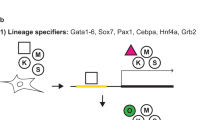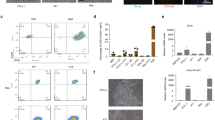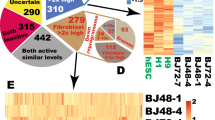Abstract
The introduction of four transcription factors Oct4, Klf4, Sox2 and c-Myc by viral transduction can induce reprogramming of somatic cells into induced pluripotent stem cells (iPSCs), but the use of iPSCs is hindered by the use of viral delivery systems. Chemical-induced reprogramming offers a novel approach to generating iPSCs without any viral vector-based genetic modification. Previous reports showed that several small molecules could replace some of the reprogramming factors although at least two transcription factors, Oct4 and Klf4, are still required to generate iPSCs from mouse embryonic fibroblasts. Here, we identify a specific chemical combination, which is sufficient to permit reprogramming from mouse embryonic and adult fibroblasts in the presence of a single transcription factor, Oct4, within 20 days, replacing Sox2, Klf4 and c-Myc. The iPSCs generated using this treatment resembled mouse embryonic stem cells in terms of global gene expression profile, epigenetic status and pluripotency both in vitro and in vivo. We also found that 8 days of Oct4 induction was sufficient to enable Oct4-induced reprogramming in the presence of the small molecules, which suggests that reprogramming was initiated within the first 8 days and was independent of continuous exogenous Oct4 expression. These discoveries will aid in the future generation of iPSCs without genetic modification, as well as elucidating the molecular mechanisms that underlie the reprogramming process.
Similar content being viewed by others
Log in or create a free account to read this content
Gain free access to this article, as well as selected content from this journal and more on nature.com
or
References
Takahashi K, Yamanaka S . Induction of pluripotent stem cells from mouse embryonic and adult fibroblast cultures by defined factors. Cell 2006; 126:663–676.
Takahashi K, Tanabe K, Ohnuki M, et al. Induction of pluripotent stem cells from adult human fibroblasts by defined factors. Cell 2007; 131:861–872.
Okita K, Ichisaka T, Yamanaka S . Generation of germline-competent induced pluripotent stem cells. Nature 2007; 448:313–317.
Wernig M, Meissner A, Foreman R, et al. In vitro reprogramming of fibroblasts into a pluripotent ES-cell-like state. Nature 2007; 448:318–324.
Zhou H, Wu S, Joo JY, et al. Generation of induced pluripotent stem cells using recombinant proteins. Cell Stem Cell 2009; 4:381–384.
Kim D, Kim CH, Moon JI, et al. Generation of human induced pluripotent stem cells by direct delivery of reprogramming proteins. Cell Stem Cell 2009; 4:472–476.
Stadtfeld M, Nagaya M, Utikal J, Weir G, Hochedlinger K . Induced pluripotent stem cells generated without viral integration. Science 2008; 322:945–949.
Okita K, Nakagawa M, Hyenjong H, Ichisaka T, Yamanaka S . Generation of mouse induced pluripotent stem cells without viral vectors. Science 2008; 322:949–953.
Huangfu D, Maehr R, Guo W, et al. Induction of pluripotent stem cells by defined factors is greatly improved by small-molecule compounds. Nat Biotechnol 2008; 26:795–797.
Mikkelsen TS, Hanna J, Zhang X, et al. Dissecting direct reprogramming through integrative genomic analysis. Nature 2008; 454:49–55.
Esteban MA, Wang T, Qin B, et al. Vitamin C enhances the generation of mouse and human induced pluripotent stem cells. Cell Stem Cell 2010; 6:71–79.
Mali P, Chou BK, Yen J, et al. Butyrate greatly enhances derivation of human induced pluripotent stem cells by promoting epigenetic remodeling and the expression of pluripotency-associated genes. Stem Cells 2010; 28:713–720.
Silva J, Barrandon O, Nichols J, et al. Promotion of reprogramming to ground state pluripotency by signal inhibition. PLoS Biol 2008; 6:e253.
Shi Y, Do JT, Desponts C, et al. A combined chemical and genetic approach for the generation of induced pluripotent stem cells. Cell Stem Cell 2008; 2:525–528.
Lyssiotis CA, Foreman RK, Staerk J, et al. Reprogramming of murine fibroblasts to induced pluripotent stem cells with chemical complementation of Klf4. Proc Natl Acad Sci USA 2009; 106:8912–8917.
Maherali N, Hochedlinger K . Tgfbeta signal inhibition cooperates in the induction of iPSCs and replaces Sox2 and cMyc. Curr Biol 2009; 19:1718–1723.
Ichida JK, Blanchard J, Lam K, et al. A small-molecule inhibitor of tgf-Beta signaling replaces sox2 in reprogramming by inducing nanog. Cell Stem Cell 2009; 5:491–503.
Woltjen K, Stanford WL . Inhibition of tgf-Beta signaling improves mouse fibroblast reprogramming. Cell Stem Cell 2009; 5:457–458.
Maherali N, Ahfeldt T, Rigamonti A, et al. A high-efficiency system for the generation and study of human induced pluripotent stem cells. Cell Stem Cell 2008; 3:340–345.
Wernig M, Lengner CJ, Hanna J, et al. A drug-inducible transgenic system for direct reprogramming of multiple somatic cell types. Nat Biotechnol 2008; 26:916–924.
Jaenisch R, Young R . Stem cells, the molecular circuitry of pluripotency and nuclear reprogramming. Cell 2008; 132:567–582.
Yamanaka S . Strategies and new developments in the generation of patient-specific pluripotent stem cells. Cell Stem Cell 2007; 1:39–49.
Huangfu D, Osafune K, Maehr R, et al. Induction of pluripotent stem cells from primary human fibroblasts with only Oct4 and Sox2. Nat Biotechnol 2008; 26:1269–1275.
Li W, Zhou H, Abujarour R, et al. Generation of human-induced pluripotent stem cells in the absence of exogenous Sox2. Stem Cells 2009; 27:2992–3000.
Lee MG, Wynder C, Schmidt DM, McCafferty DG, Shiekhattar R . Histone H3 lysine 4 demethylation is a target of nonselective antidepressive medications. Chem Biol 2006; 13:563–567.
Marson A, Foreman R, Chevalier B, et al. Wnt signaling promotes reprogramming of somatic cells to pluripotency. Cell Stem Cell 2008; 3:132–135.
Cartwright P, McLean C, Sheppard A, et al. LIF/STAT3 controls ES cell self-renewal and pluripotency by a Myc-dependent mechanism. Development 2005; 132:885–896.
Das S, Becker BN, Hoffmann FM, Mertz JE . Complete reversal of epithelial to mesenchymal transition requires inhibition of both ZEB expression and the Rho pathway. BMC Cell Biol 2009; 10:94.
Polo JM, Hochedlinger K . When fibroblasts MET iPSCs. Cell Stem Cell 2010; 7:5–6.
Li R, Liang J, Ni S, et al. A mesenchymal-to-epithelial transition initiates and is required for the nuclear reprogramming of mouse fibroblasts. Cell Stem Cell 2010; 7:51–63.
Kim JB, Sebastiano V, Wu G, et al. Oct4-induced pluripotency in adult neural stem cells. Cell 2009; 136:411–419.
Zhao Y, Yin X, Qin H, et al. Two supporting factors greatly improve the efficiency of human iPSC generation. Cell Stem Cell 2008; 3:475–479.
Acknowledgements
We thank JY Guan, JQ Ye, X Li, GF Meng, T Zhao, TT Xiang, JC Wang, HS Liu, X Zhang and X Sui (Peking University) for technical assistance and Dr Hochedlinger (Harvard University) for providing the doxycycline (Dox)-inducible lentiviral vectors. This research was supported by a Ministry of Science and Technology grant (2006AA02A113), Beijing Nature Science Foundation Grant (5100002), Science and Technology Plan of Beijing Municipal Government (D07050701350705), National Basic Research Program for China (973 Program 2009CB941101, 2010CB945204), National Natural Science Foundation of China (90919031 and 30421004), the Chinese Science and Technology Key Project (2009zx10004-403), a Bill and Melinda Gates Foundation Grant (37871) and a 111 Project to HD.
Author information
Authors and Affiliations
Corresponding authors
Additional information
( Supplementary information is linked to the online version of the paper on the Cell Research website.)
Supplementary information
Supplementary information, Figure S1
Small molecules used at different concentrations in Oct4-induced reprogramming. (PDF 485 kb)
Supplementary information, Figure S2
iPSCs induced from adult mouse fibroblasts by Oct4 and small molecules. (PDF 5438 kb)
Supplementary information, Figure S3
Endogenous expression of reprogramming factors in oct4-induced reprogramming. (PDF 505 kb)
Supplementary information, Table S1
Primers for RT-PCR and genome PCR test. (PDF 56 kb)
Rights and permissions
About this article
Cite this article
Li, Y., Zhang, Q., Yin, X. et al. Generation of iPSCs from mouse fibroblasts with a single gene, Oct4, and small molecules. Cell Res 21, 196–204 (2011). https://doi.org/10.1038/cr.2010.142
Received:
Revised:
Accepted:
Published:
Issue date:
DOI: https://doi.org/10.1038/cr.2010.142
Keywords
This article is cited by
-
Differential regulation of H3K9/H3K14 acetylation by small molecules drives neuron-fate-induction of glioma cell
Cell Death & Disease (2023)
-
H3K27ac mediated SS18/BAFs relocation regulates JUN induced pluripotent-somatic transition
Cell & Bioscience (2022)
-
“Cutting the Mustard” with Induced Pluripotent Stem Cells: An Overview and Applications in Healthcare Paradigm
Stem Cell Reviews and Reports (2022)
-
Biological importance of OCT transcription factors in reprogramming and development
Experimental & Molecular Medicine (2021)
-
Direct reprogramming of epithelial cell rests of malassez into mesenchymal-like cells by epigenetic agents
Scientific Reports (2021)



